Emergency Management: UK & International Incident Analysis Report
VerifiedAdded on 2020/10/22
|12
|3665
|142
Report
AI Summary
This report comprehensively examines integrated emergency management, focusing on the principles of effective incident response, including expectation, readiness, direction, information, integration, and cooperation. It explores the recovery stage following an emergency, detailing reconstruction, reinstatement, and various categories of recovery, such as humanistic, economical, and infrastructural aspects. The report emphasizes the importance of debriefs and reviews for future planning and responding, supported by a range of UK and international emergency incident examples, including the Grenfell Tower Fire. Furthermore, it investigates the role of public services, particularly the Department for Environment, Food and Rural Affairs (DEFRA), in real-world emergency incidents, and evaluates a specific incident, analyzing actions taken, collaborative agency work, and lessons learned. The report provides a detailed analysis of emergency management strategies and their application in diverse scenarios.
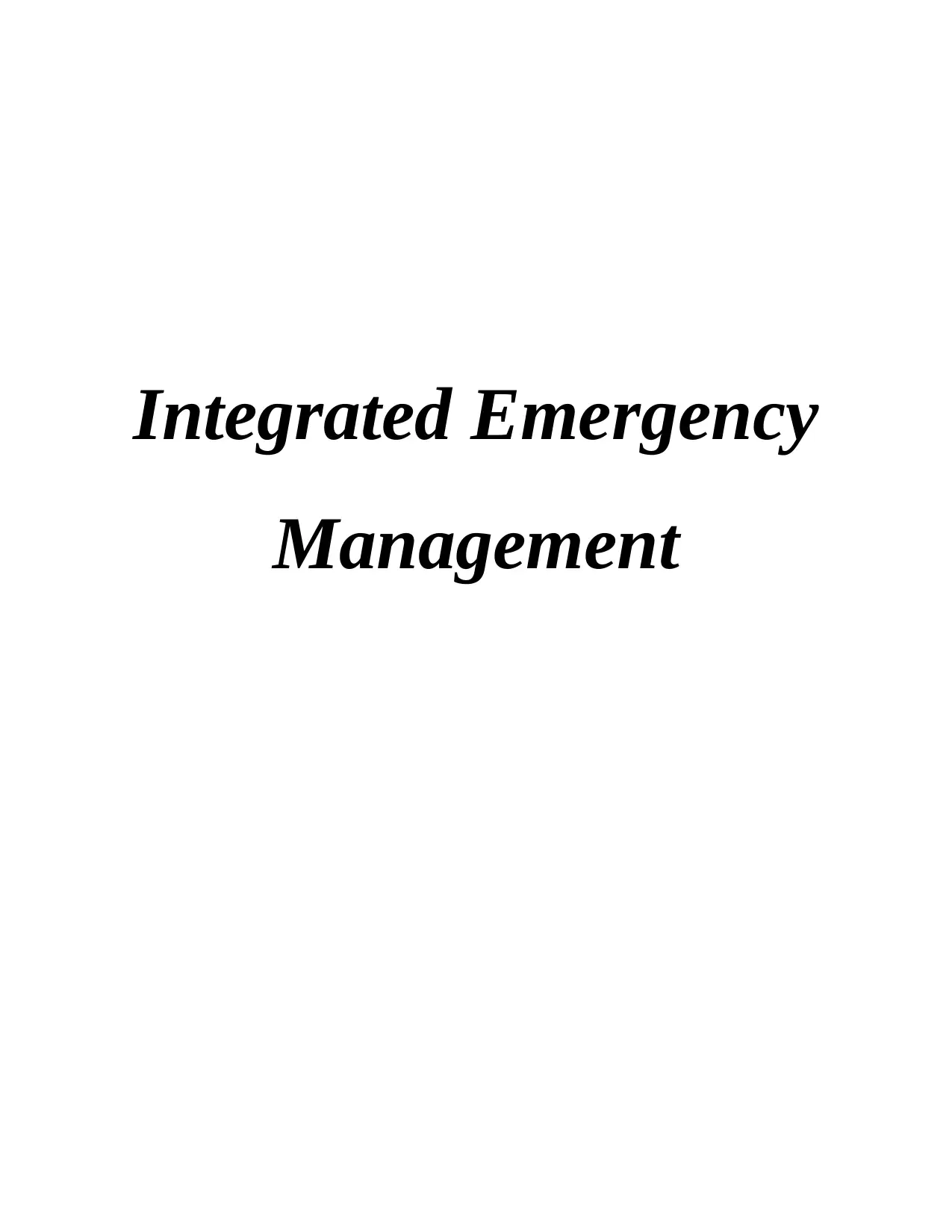
Integrated Emergency
Management
Management
Paraphrase This Document
Need a fresh take? Get an instant paraphrase of this document with our AI Paraphraser
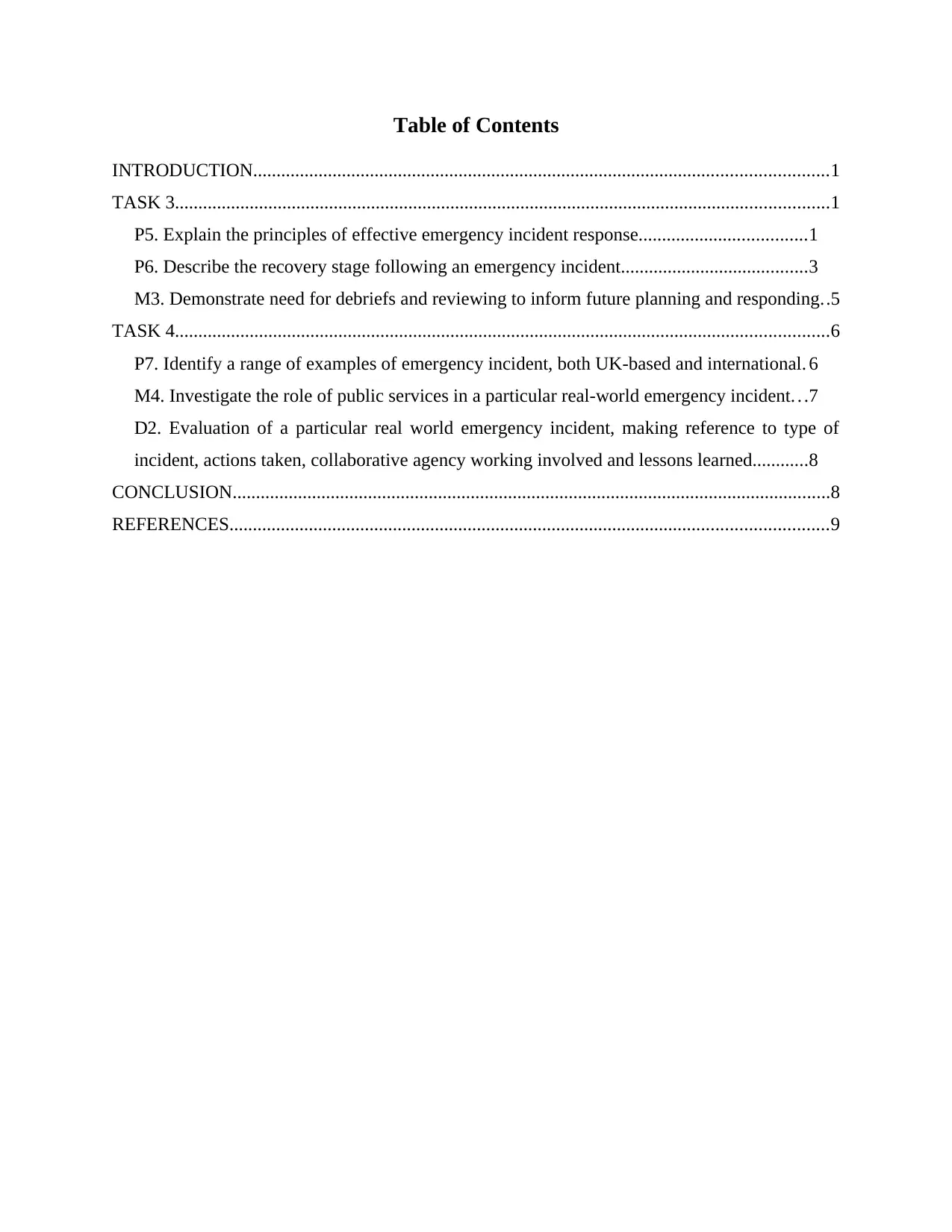
Table of Contents
INTRODUCTION...........................................................................................................................1
TASK 3............................................................................................................................................1
P5. Explain the principles of effective emergency incident response....................................1
P6. Describe the recovery stage following an emergency incident........................................3
M3. Demonstrate need for debriefs and reviewing to inform future planning and responding..5
TASK 4............................................................................................................................................6
P7. Identify a range of examples of emergency incident, both UK-based and international. 6
M4. Investigate the role of public services in a particular real-world emergency incident. . .7
D2. Evaluation of a particular real world emergency incident, making reference to type of
incident, actions taken, collaborative agency working involved and lessons learned............8
CONCLUSION................................................................................................................................8
REFERENCES................................................................................................................................9
INTRODUCTION...........................................................................................................................1
TASK 3............................................................................................................................................1
P5. Explain the principles of effective emergency incident response....................................1
P6. Describe the recovery stage following an emergency incident........................................3
M3. Demonstrate need for debriefs and reviewing to inform future planning and responding..5
TASK 4............................................................................................................................................6
P7. Identify a range of examples of emergency incident, both UK-based and international. 6
M4. Investigate the role of public services in a particular real-world emergency incident. . .7
D2. Evaluation of a particular real world emergency incident, making reference to type of
incident, actions taken, collaborative agency working involved and lessons learned............8
CONCLUSION................................................................................................................................8
REFERENCES................................................................................................................................9
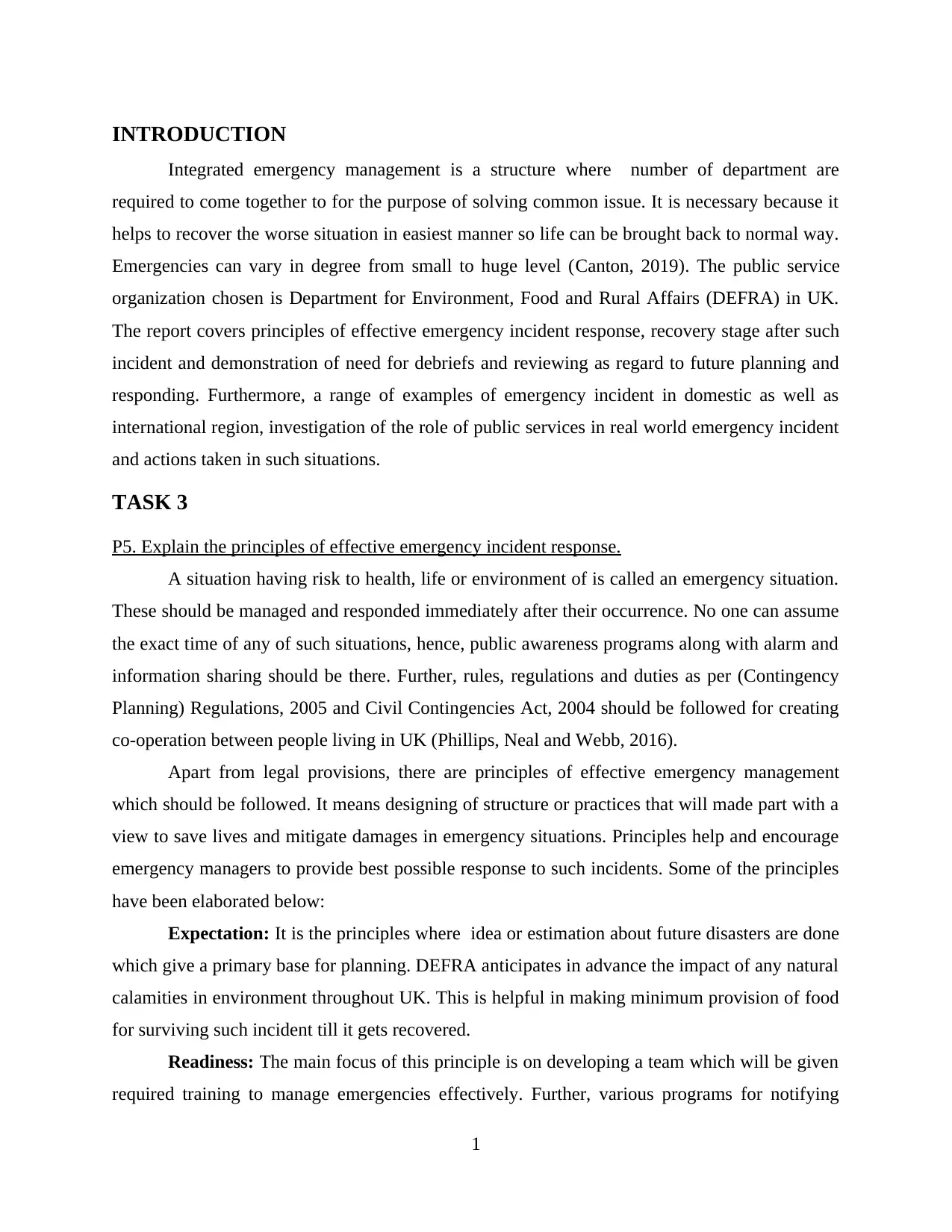
INTRODUCTION
Integrated emergency management is a structure where number of department are
required to come together to for the purpose of solving common issue. It is necessary because it
helps to recover the worse situation in easiest manner so life can be brought back to normal way.
Emergencies can vary in degree from small to huge level (Canton, 2019). The public service
organization chosen is Department for Environment, Food and Rural Affairs (DEFRA) in UK.
The report covers principles of effective emergency incident response, recovery stage after such
incident and demonstration of need for debriefs and reviewing as regard to future planning and
responding. Furthermore, a range of examples of emergency incident in domestic as well as
international region, investigation of the role of public services in real world emergency incident
and actions taken in such situations.
TASK 3
P5. Explain the principles of effective emergency incident response.
A situation having risk to health, life or environment of is called an emergency situation.
These should be managed and responded immediately after their occurrence. No one can assume
the exact time of any of such situations, hence, public awareness programs along with alarm and
information sharing should be there. Further, rules, regulations and duties as per (Contingency
Planning) Regulations, 2005 and Civil Contingencies Act, 2004 should be followed for creating
co-operation between people living in UK (Phillips, Neal and Webb, 2016).
Apart from legal provisions, there are principles of effective emergency management
which should be followed. It means designing of structure or practices that will made part with a
view to save lives and mitigate damages in emergency situations. Principles help and encourage
emergency managers to provide best possible response to such incidents. Some of the principles
have been elaborated below:
Expectation: It is the principles where idea or estimation about future disasters are done
which give a primary base for planning. DEFRA anticipates in advance the impact of any natural
calamities in environment throughout UK. This is helpful in making minimum provision of food
for surviving such incident till it gets recovered.
Readiness: The main focus of this principle is on developing a team which will be given
required training to manage emergencies effectively. Further, various programs for notifying
1
Integrated emergency management is a structure where number of department are
required to come together to for the purpose of solving common issue. It is necessary because it
helps to recover the worse situation in easiest manner so life can be brought back to normal way.
Emergencies can vary in degree from small to huge level (Canton, 2019). The public service
organization chosen is Department for Environment, Food and Rural Affairs (DEFRA) in UK.
The report covers principles of effective emergency incident response, recovery stage after such
incident and demonstration of need for debriefs and reviewing as regard to future planning and
responding. Furthermore, a range of examples of emergency incident in domestic as well as
international region, investigation of the role of public services in real world emergency incident
and actions taken in such situations.
TASK 3
P5. Explain the principles of effective emergency incident response.
A situation having risk to health, life or environment of is called an emergency situation.
These should be managed and responded immediately after their occurrence. No one can assume
the exact time of any of such situations, hence, public awareness programs along with alarm and
information sharing should be there. Further, rules, regulations and duties as per (Contingency
Planning) Regulations, 2005 and Civil Contingencies Act, 2004 should be followed for creating
co-operation between people living in UK (Phillips, Neal and Webb, 2016).
Apart from legal provisions, there are principles of effective emergency management
which should be followed. It means designing of structure or practices that will made part with a
view to save lives and mitigate damages in emergency situations. Principles help and encourage
emergency managers to provide best possible response to such incidents. Some of the principles
have been elaborated below:
Expectation: It is the principles where idea or estimation about future disasters are done
which give a primary base for planning. DEFRA anticipates in advance the impact of any natural
calamities in environment throughout UK. This is helpful in making minimum provision of food
for surviving such incident till it gets recovered.
Readiness: The main focus of this principle is on developing a team which will be given
required training to manage emergencies effectively. Further, various programs for notifying
1
⊘ This is a preview!⊘
Do you want full access?
Subscribe today to unlock all pages.

Trusted by 1+ million students worldwide
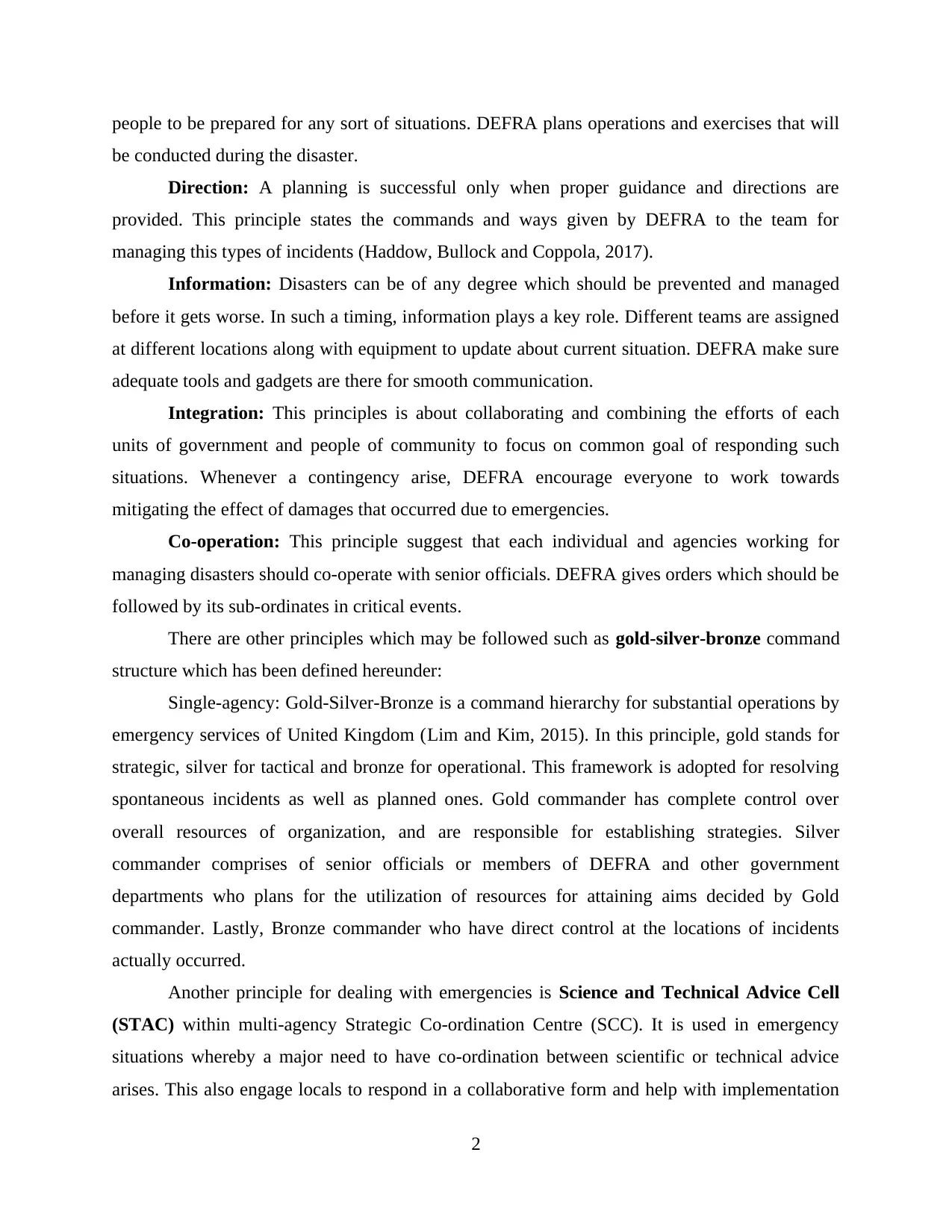
people to be prepared for any sort of situations. DEFRA plans operations and exercises that will
be conducted during the disaster.
Direction: A planning is successful only when proper guidance and directions are
provided. This principle states the commands and ways given by DEFRA to the team for
managing this types of incidents (Haddow, Bullock and Coppola, 2017).
Information: Disasters can be of any degree which should be prevented and managed
before it gets worse. In such a timing, information plays a key role. Different teams are assigned
at different locations along with equipment to update about current situation. DEFRA make sure
adequate tools and gadgets are there for smooth communication.
Integration: This principles is about collaborating and combining the efforts of each
units of government and people of community to focus on common goal of responding such
situations. Whenever a contingency arise, DEFRA encourage everyone to work towards
mitigating the effect of damages that occurred due to emergencies.
Co-operation: This principle suggest that each individual and agencies working for
managing disasters should co-operate with senior officials. DEFRA gives orders which should be
followed by its sub-ordinates in critical events.
There are other principles which may be followed such as gold-silver-bronze command
structure which has been defined hereunder:
Single-agency: Gold-Silver-Bronze is a command hierarchy for substantial operations by
emergency services of United Kingdom (Lim and Kim, 2015). In this principle, gold stands for
strategic, silver for tactical and bronze for operational. This framework is adopted for resolving
spontaneous incidents as well as planned ones. Gold commander has complete control over
overall resources of organization, and are responsible for establishing strategies. Silver
commander comprises of senior officials or members of DEFRA and other government
departments who plans for the utilization of resources for attaining aims decided by Gold
commander. Lastly, Bronze commander who have direct control at the locations of incidents
actually occurred.
Another principle for dealing with emergencies is Science and Technical Advice Cell
(STAC) within multi-agency Strategic Co-ordination Centre (SCC). It is used in emergency
situations whereby a major need to have co-ordination between scientific or technical advice
arises. This also engage locals to respond in a collaborative form and help with implementation
2
be conducted during the disaster.
Direction: A planning is successful only when proper guidance and directions are
provided. This principle states the commands and ways given by DEFRA to the team for
managing this types of incidents (Haddow, Bullock and Coppola, 2017).
Information: Disasters can be of any degree which should be prevented and managed
before it gets worse. In such a timing, information plays a key role. Different teams are assigned
at different locations along with equipment to update about current situation. DEFRA make sure
adequate tools and gadgets are there for smooth communication.
Integration: This principles is about collaborating and combining the efforts of each
units of government and people of community to focus on common goal of responding such
situations. Whenever a contingency arise, DEFRA encourage everyone to work towards
mitigating the effect of damages that occurred due to emergencies.
Co-operation: This principle suggest that each individual and agencies working for
managing disasters should co-operate with senior officials. DEFRA gives orders which should be
followed by its sub-ordinates in critical events.
There are other principles which may be followed such as gold-silver-bronze command
structure which has been defined hereunder:
Single-agency: Gold-Silver-Bronze is a command hierarchy for substantial operations by
emergency services of United Kingdom (Lim and Kim, 2015). In this principle, gold stands for
strategic, silver for tactical and bronze for operational. This framework is adopted for resolving
spontaneous incidents as well as planned ones. Gold commander has complete control over
overall resources of organization, and are responsible for establishing strategies. Silver
commander comprises of senior officials or members of DEFRA and other government
departments who plans for the utilization of resources for attaining aims decided by Gold
commander. Lastly, Bronze commander who have direct control at the locations of incidents
actually occurred.
Another principle for dealing with emergencies is Science and Technical Advice Cell
(STAC) within multi-agency Strategic Co-ordination Centre (SCC). It is used in emergency
situations whereby a major need to have co-ordination between scientific or technical advice
arises. This also engage locals to respond in a collaborative form and help with implementation
2
Paraphrase This Document
Need a fresh take? Get an instant paraphrase of this document with our AI Paraphraser
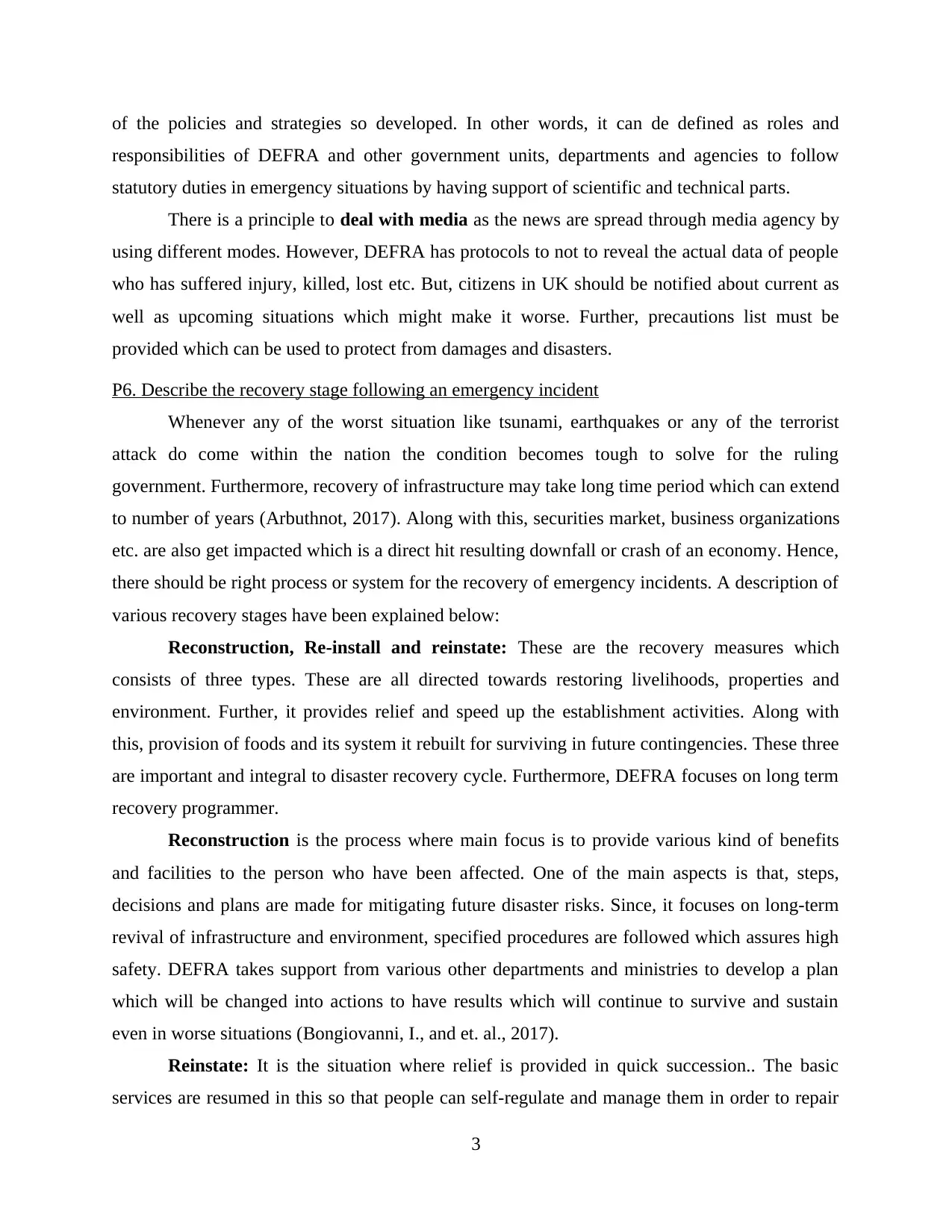
of the policies and strategies so developed. In other words, it can de defined as roles and
responsibilities of DEFRA and other government units, departments and agencies to follow
statutory duties in emergency situations by having support of scientific and technical parts.
There is a principle to deal with media as the news are spread through media agency by
using different modes. However, DEFRA has protocols to not to reveal the actual data of people
who has suffered injury, killed, lost etc. But, citizens in UK should be notified about current as
well as upcoming situations which might make it worse. Further, precautions list must be
provided which can be used to protect from damages and disasters.
P6. Describe the recovery stage following an emergency incident
Whenever any of the worst situation like tsunami, earthquakes or any of the terrorist
attack do come within the nation the condition becomes tough to solve for the ruling
government. Furthermore, recovery of infrastructure may take long time period which can extend
to number of years (Arbuthnot, 2017). Along with this, securities market, business organizations
etc. are also get impacted which is a direct hit resulting downfall or crash of an economy. Hence,
there should be right process or system for the recovery of emergency incidents. A description of
various recovery stages have been explained below:
Reconstruction, Re-install and reinstate: These are the recovery measures which
consists of three types. These are all directed towards restoring livelihoods, properties and
environment. Further, it provides relief and speed up the establishment activities. Along with
this, provision of foods and its system it rebuilt for surviving in future contingencies. These three
are important and integral to disaster recovery cycle. Furthermore, DEFRA focuses on long term
recovery programmer.
Reconstruction is the process where main focus is to provide various kind of benefits
and facilities to the person who have been affected. One of the main aspects is that, steps,
decisions and plans are made for mitigating future disaster risks. Since, it focuses on long-term
revival of infrastructure and environment, specified procedures are followed which assures high
safety. DEFRA takes support from various other departments and ministries to develop a plan
which will be changed into actions to have results which will continue to survive and sustain
even in worse situations (Bongiovanni, I., and et. al., 2017).
Reinstate: It is the situation where relief is provided in quick succession.. The basic
services are resumed in this so that people can self-regulate and manage them in order to repair
3
responsibilities of DEFRA and other government units, departments and agencies to follow
statutory duties in emergency situations by having support of scientific and technical parts.
There is a principle to deal with media as the news are spread through media agency by
using different modes. However, DEFRA has protocols to not to reveal the actual data of people
who has suffered injury, killed, lost etc. But, citizens in UK should be notified about current as
well as upcoming situations which might make it worse. Further, precautions list must be
provided which can be used to protect from damages and disasters.
P6. Describe the recovery stage following an emergency incident
Whenever any of the worst situation like tsunami, earthquakes or any of the terrorist
attack do come within the nation the condition becomes tough to solve for the ruling
government. Furthermore, recovery of infrastructure may take long time period which can extend
to number of years (Arbuthnot, 2017). Along with this, securities market, business organizations
etc. are also get impacted which is a direct hit resulting downfall or crash of an economy. Hence,
there should be right process or system for the recovery of emergency incidents. A description of
various recovery stages have been explained below:
Reconstruction, Re-install and reinstate: These are the recovery measures which
consists of three types. These are all directed towards restoring livelihoods, properties and
environment. Further, it provides relief and speed up the establishment activities. Along with
this, provision of foods and its system it rebuilt for surviving in future contingencies. These three
are important and integral to disaster recovery cycle. Furthermore, DEFRA focuses on long term
recovery programmer.
Reconstruction is the process where main focus is to provide various kind of benefits
and facilities to the person who have been affected. One of the main aspects is that, steps,
decisions and plans are made for mitigating future disaster risks. Since, it focuses on long-term
revival of infrastructure and environment, specified procedures are followed which assures high
safety. DEFRA takes support from various other departments and ministries to develop a plan
which will be changed into actions to have results which will continue to survive and sustain
even in worse situations (Bongiovanni, I., and et. al., 2017).
Reinstate: It is the situation where relief is provided in quick succession.. The basic
services are resumed in this so that people can self-regulate and manage them in order to repair
3
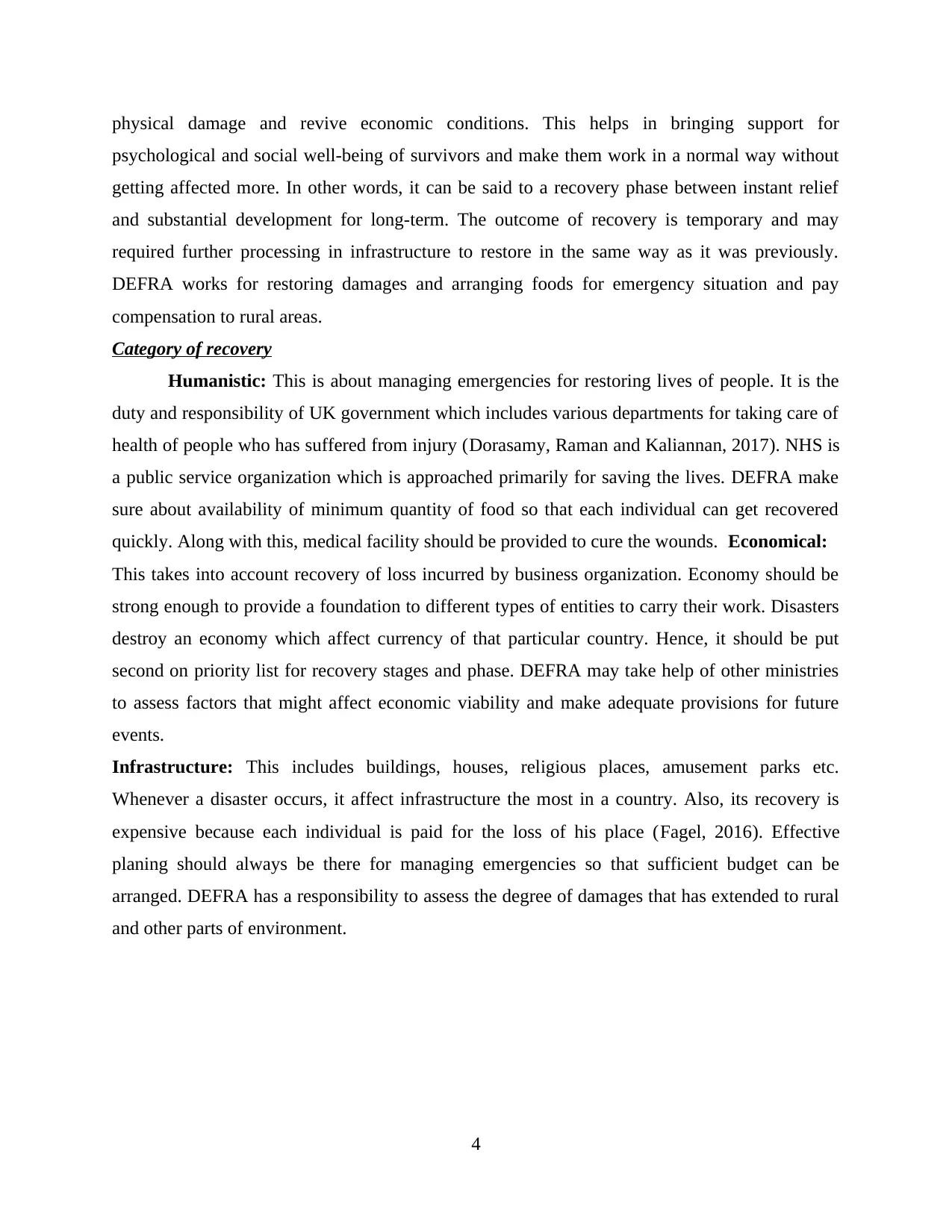
physical damage and revive economic conditions. This helps in bringing support for
psychological and social well-being of survivors and make them work in a normal way without
getting affected more. In other words, it can be said to a recovery phase between instant relief
and substantial development for long-term. The outcome of recovery is temporary and may
required further processing in infrastructure to restore in the same way as it was previously.
DEFRA works for restoring damages and arranging foods for emergency situation and pay
compensation to rural areas.
Category of recovery
Humanistic: This is about managing emergencies for restoring lives of people. It is the
duty and responsibility of UK government which includes various departments for taking care of
health of people who has suffered from injury (Dorasamy, Raman and Kaliannan, 2017). NHS is
a public service organization which is approached primarily for saving the lives. DEFRA make
sure about availability of minimum quantity of food so that each individual can get recovered
quickly. Along with this, medical facility should be provided to cure the wounds. Economical:
This takes into account recovery of loss incurred by business organization. Economy should be
strong enough to provide a foundation to different types of entities to carry their work. Disasters
destroy an economy which affect currency of that particular country. Hence, it should be put
second on priority list for recovery stages and phase. DEFRA may take help of other ministries
to assess factors that might affect economic viability and make adequate provisions for future
events.
Infrastructure: This includes buildings, houses, religious places, amusement parks etc.
Whenever a disaster occurs, it affect infrastructure the most in a country. Also, its recovery is
expensive because each individual is paid for the loss of his place (Fagel, 2016). Effective
planing should always be there for managing emergencies so that sufficient budget can be
arranged. DEFRA has a responsibility to assess the degree of damages that has extended to rural
and other parts of environment.
4
psychological and social well-being of survivors and make them work in a normal way without
getting affected more. In other words, it can be said to a recovery phase between instant relief
and substantial development for long-term. The outcome of recovery is temporary and may
required further processing in infrastructure to restore in the same way as it was previously.
DEFRA works for restoring damages and arranging foods for emergency situation and pay
compensation to rural areas.
Category of recovery
Humanistic: This is about managing emergencies for restoring lives of people. It is the
duty and responsibility of UK government which includes various departments for taking care of
health of people who has suffered from injury (Dorasamy, Raman and Kaliannan, 2017). NHS is
a public service organization which is approached primarily for saving the lives. DEFRA make
sure about availability of minimum quantity of food so that each individual can get recovered
quickly. Along with this, medical facility should be provided to cure the wounds. Economical:
This takes into account recovery of loss incurred by business organization. Economy should be
strong enough to provide a foundation to different types of entities to carry their work. Disasters
destroy an economy which affect currency of that particular country. Hence, it should be put
second on priority list for recovery stages and phase. DEFRA may take help of other ministries
to assess factors that might affect economic viability and make adequate provisions for future
events.
Infrastructure: This includes buildings, houses, religious places, amusement parks etc.
Whenever a disaster occurs, it affect infrastructure the most in a country. Also, its recovery is
expensive because each individual is paid for the loss of his place (Fagel, 2016). Effective
planing should always be there for managing emergencies so that sufficient budget can be
arranged. DEFRA has a responsibility to assess the degree of damages that has extended to rural
and other parts of environment.
4
⊘ This is a preview!⊘
Do you want full access?
Subscribe today to unlock all pages.

Trusted by 1+ million students worldwide
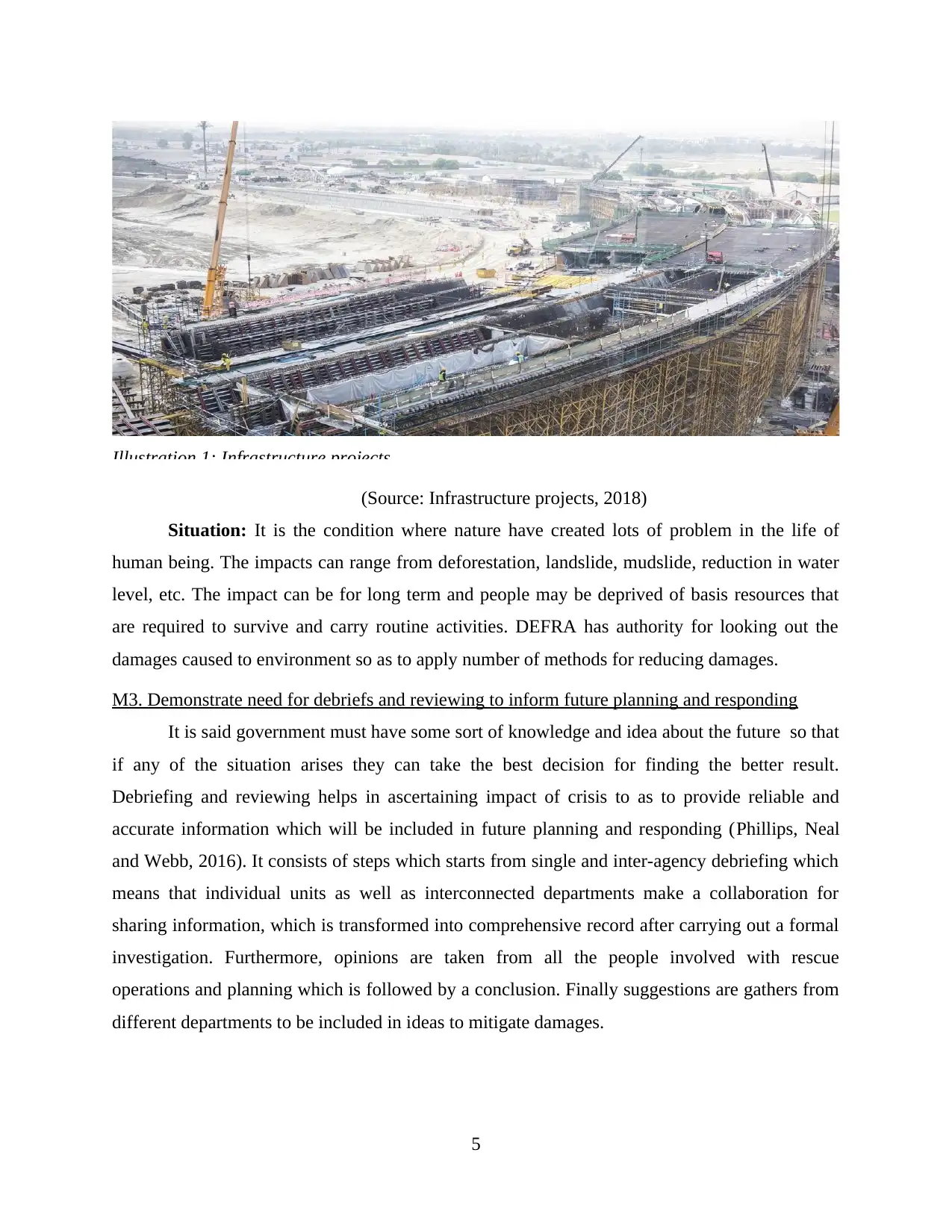
Illustration 1: Infrastructure projects
(Source: Infrastructure projects, 2018)
Situation: It is the condition where nature have created lots of problem in the life of
human being. The impacts can range from deforestation, landslide, mudslide, reduction in water
level, etc. The impact can be for long term and people may be deprived of basis resources that
are required to survive and carry routine activities. DEFRA has authority for looking out the
damages caused to environment so as to apply number of methods for reducing damages.
M3. Demonstrate need for debriefs and reviewing to inform future planning and responding
It is said government must have some sort of knowledge and idea about the future so that
if any of the situation arises they can take the best decision for finding the better result.
Debriefing and reviewing helps in ascertaining impact of crisis to as to provide reliable and
accurate information which will be included in future planning and responding (Phillips, Neal
and Webb, 2016). It consists of steps which starts from single and inter-agency debriefing which
means that individual units as well as interconnected departments make a collaboration for
sharing information, which is transformed into comprehensive record after carrying out a formal
investigation. Furthermore, opinions are taken from all the people involved with rescue
operations and planning which is followed by a conclusion. Finally suggestions are gathers from
different departments to be included in ideas to mitigate damages.
5
(Source: Infrastructure projects, 2018)
Situation: It is the condition where nature have created lots of problem in the life of
human being. The impacts can range from deforestation, landslide, mudslide, reduction in water
level, etc. The impact can be for long term and people may be deprived of basis resources that
are required to survive and carry routine activities. DEFRA has authority for looking out the
damages caused to environment so as to apply number of methods for reducing damages.
M3. Demonstrate need for debriefs and reviewing to inform future planning and responding
It is said government must have some sort of knowledge and idea about the future so that
if any of the situation arises they can take the best decision for finding the better result.
Debriefing and reviewing helps in ascertaining impact of crisis to as to provide reliable and
accurate information which will be included in future planning and responding (Phillips, Neal
and Webb, 2016). It consists of steps which starts from single and inter-agency debriefing which
means that individual units as well as interconnected departments make a collaboration for
sharing information, which is transformed into comprehensive record after carrying out a formal
investigation. Furthermore, opinions are taken from all the people involved with rescue
operations and planning which is followed by a conclusion. Finally suggestions are gathers from
different departments to be included in ideas to mitigate damages.
5
Paraphrase This Document
Need a fresh take? Get an instant paraphrase of this document with our AI Paraphraser
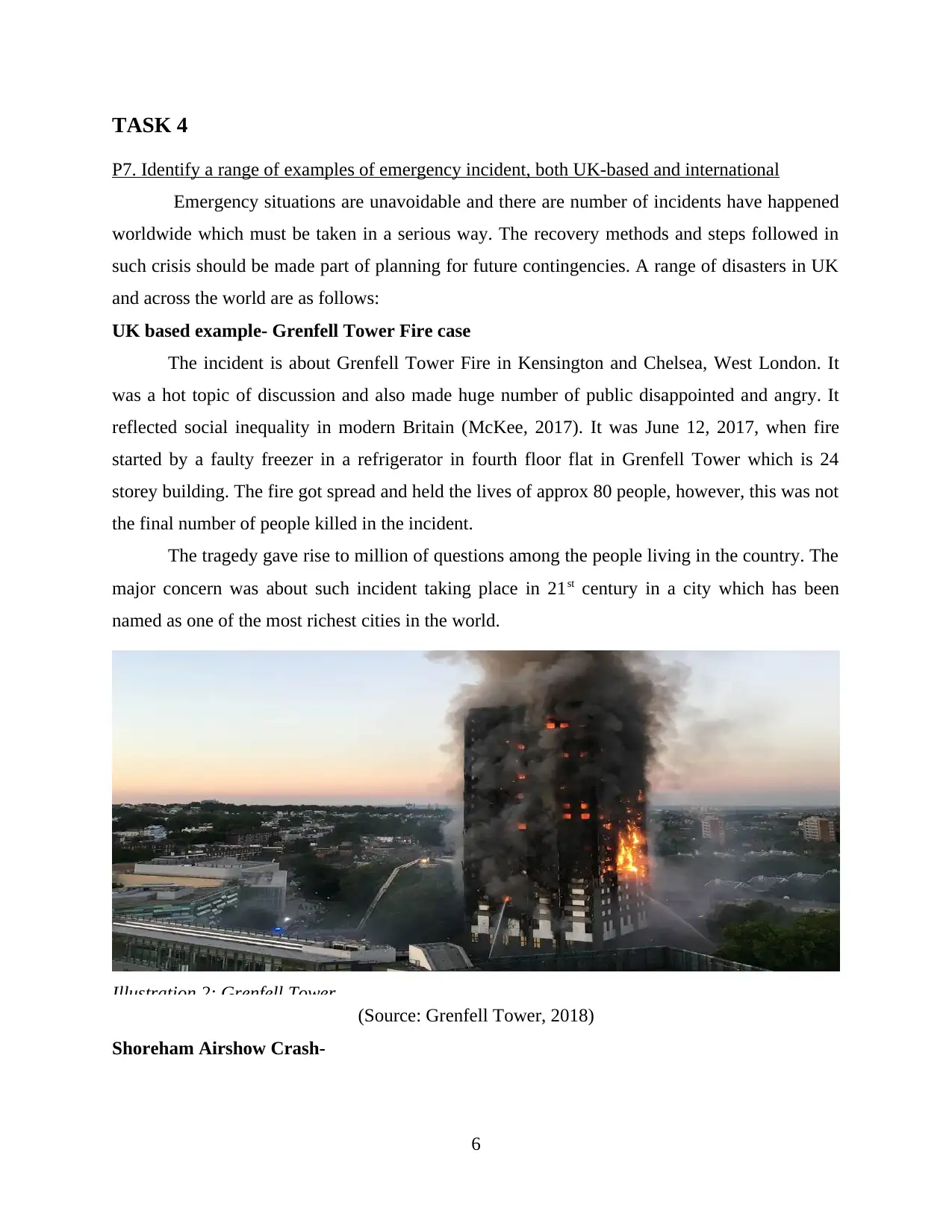
TASK 4
P7. Identify a range of examples of emergency incident, both UK-based and international
Emergency situations are unavoidable and there are number of incidents have happened
worldwide which must be taken in a serious way. The recovery methods and steps followed in
such crisis should be made part of planning for future contingencies. A range of disasters in UK
and across the world are as follows:
UK based example- Grenfell Tower Fire case
The incident is about Grenfell Tower Fire in Kensington and Chelsea, West London. It
was a hot topic of discussion and also made huge number of public disappointed and angry. It
reflected social inequality in modern Britain (McKee, 2017). It was June 12, 2017, when fire
started by a faulty freezer in a refrigerator in fourth floor flat in Grenfell Tower which is 24
storey building. The fire got spread and held the lives of approx 80 people, however, this was not
the final number of people killed in the incident.
The tragedy gave rise to million of questions among the people living in the country. The
major concern was about such incident taking place in 21st century in a city which has been
named as one of the most richest cities in the world.
Illustration 2: Grenfell Tower
(Source: Grenfell Tower, 2018)
Shoreham Airshow Crash-
6
P7. Identify a range of examples of emergency incident, both UK-based and international
Emergency situations are unavoidable and there are number of incidents have happened
worldwide which must be taken in a serious way. The recovery methods and steps followed in
such crisis should be made part of planning for future contingencies. A range of disasters in UK
and across the world are as follows:
UK based example- Grenfell Tower Fire case
The incident is about Grenfell Tower Fire in Kensington and Chelsea, West London. It
was a hot topic of discussion and also made huge number of public disappointed and angry. It
reflected social inequality in modern Britain (McKee, 2017). It was June 12, 2017, when fire
started by a faulty freezer in a refrigerator in fourth floor flat in Grenfell Tower which is 24
storey building. The fire got spread and held the lives of approx 80 people, however, this was not
the final number of people killed in the incident.
The tragedy gave rise to million of questions among the people living in the country. The
major concern was about such incident taking place in 21st century in a city which has been
named as one of the most richest cities in the world.
Illustration 2: Grenfell Tower
(Source: Grenfell Tower, 2018)
Shoreham Airshow Crash-
6
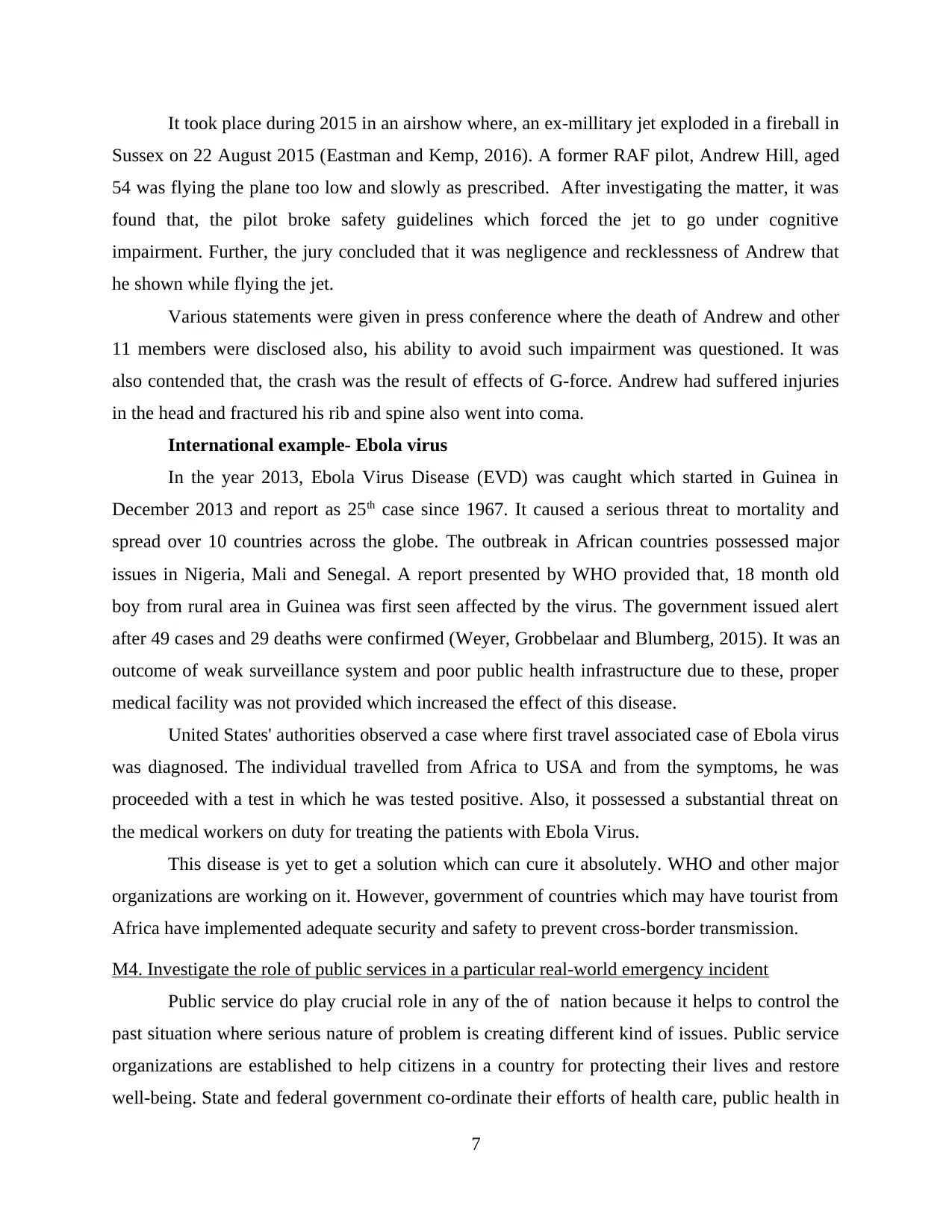
It took place during 2015 in an airshow where, an ex-millitary jet exploded in a fireball in
Sussex on 22 August 2015 (Eastman and Kemp, 2016). A former RAF pilot, Andrew Hill, aged
54 was flying the plane too low and slowly as prescribed. After investigating the matter, it was
found that, the pilot broke safety guidelines which forced the jet to go under cognitive
impairment. Further, the jury concluded that it was negligence and recklessness of Andrew that
he shown while flying the jet.
Various statements were given in press conference where the death of Andrew and other
11 members were disclosed also, his ability to avoid such impairment was questioned. It was
also contended that, the crash was the result of effects of G-force. Andrew had suffered injuries
in the head and fractured his rib and spine also went into coma.
International example- Ebola virus
In the year 2013, Ebola Virus Disease (EVD) was caught which started in Guinea in
December 2013 and report as 25th case since 1967. It caused a serious threat to mortality and
spread over 10 countries across the globe. The outbreak in African countries possessed major
issues in Nigeria, Mali and Senegal. A report presented by WHO provided that, 18 month old
boy from rural area in Guinea was first seen affected by the virus. The government issued alert
after 49 cases and 29 deaths were confirmed (Weyer, Grobbelaar and Blumberg, 2015). It was an
outcome of weak surveillance system and poor public health infrastructure due to these, proper
medical facility was not provided which increased the effect of this disease.
United States' authorities observed a case where first travel associated case of Ebola virus
was diagnosed. The individual travelled from Africa to USA and from the symptoms, he was
proceeded with a test in which he was tested positive. Also, it possessed a substantial threat on
the medical workers on duty for treating the patients with Ebola Virus.
This disease is yet to get a solution which can cure it absolutely. WHO and other major
organizations are working on it. However, government of countries which may have tourist from
Africa have implemented adequate security and safety to prevent cross-border transmission.
M4. Investigate the role of public services in a particular real-world emergency incident
Public service do play crucial role in any of the of nation because it helps to control the
past situation where serious nature of problem is creating different kind of issues. Public service
organizations are established to help citizens in a country for protecting their lives and restore
well-being. State and federal government co-ordinate their efforts of health care, public health in
7
Sussex on 22 August 2015 (Eastman and Kemp, 2016). A former RAF pilot, Andrew Hill, aged
54 was flying the plane too low and slowly as prescribed. After investigating the matter, it was
found that, the pilot broke safety guidelines which forced the jet to go under cognitive
impairment. Further, the jury concluded that it was negligence and recklessness of Andrew that
he shown while flying the jet.
Various statements were given in press conference where the death of Andrew and other
11 members were disclosed also, his ability to avoid such impairment was questioned. It was
also contended that, the crash was the result of effects of G-force. Andrew had suffered injuries
in the head and fractured his rib and spine also went into coma.
International example- Ebola virus
In the year 2013, Ebola Virus Disease (EVD) was caught which started in Guinea in
December 2013 and report as 25th case since 1967. It caused a serious threat to mortality and
spread over 10 countries across the globe. The outbreak in African countries possessed major
issues in Nigeria, Mali and Senegal. A report presented by WHO provided that, 18 month old
boy from rural area in Guinea was first seen affected by the virus. The government issued alert
after 49 cases and 29 deaths were confirmed (Weyer, Grobbelaar and Blumberg, 2015). It was an
outcome of weak surveillance system and poor public health infrastructure due to these, proper
medical facility was not provided which increased the effect of this disease.
United States' authorities observed a case where first travel associated case of Ebola virus
was diagnosed. The individual travelled from Africa to USA and from the symptoms, he was
proceeded with a test in which he was tested positive. Also, it possessed a substantial threat on
the medical workers on duty for treating the patients with Ebola Virus.
This disease is yet to get a solution which can cure it absolutely. WHO and other major
organizations are working on it. However, government of countries which may have tourist from
Africa have implemented adequate security and safety to prevent cross-border transmission.
M4. Investigate the role of public services in a particular real-world emergency incident
Public service do play crucial role in any of the of nation because it helps to control the
past situation where serious nature of problem is creating different kind of issues. Public service
organizations are established to help citizens in a country for protecting their lives and restore
well-being. State and federal government co-ordinate their efforts of health care, public health in
7
⊘ This is a preview!⊘
Do you want full access?
Subscribe today to unlock all pages.

Trusted by 1+ million students worldwide
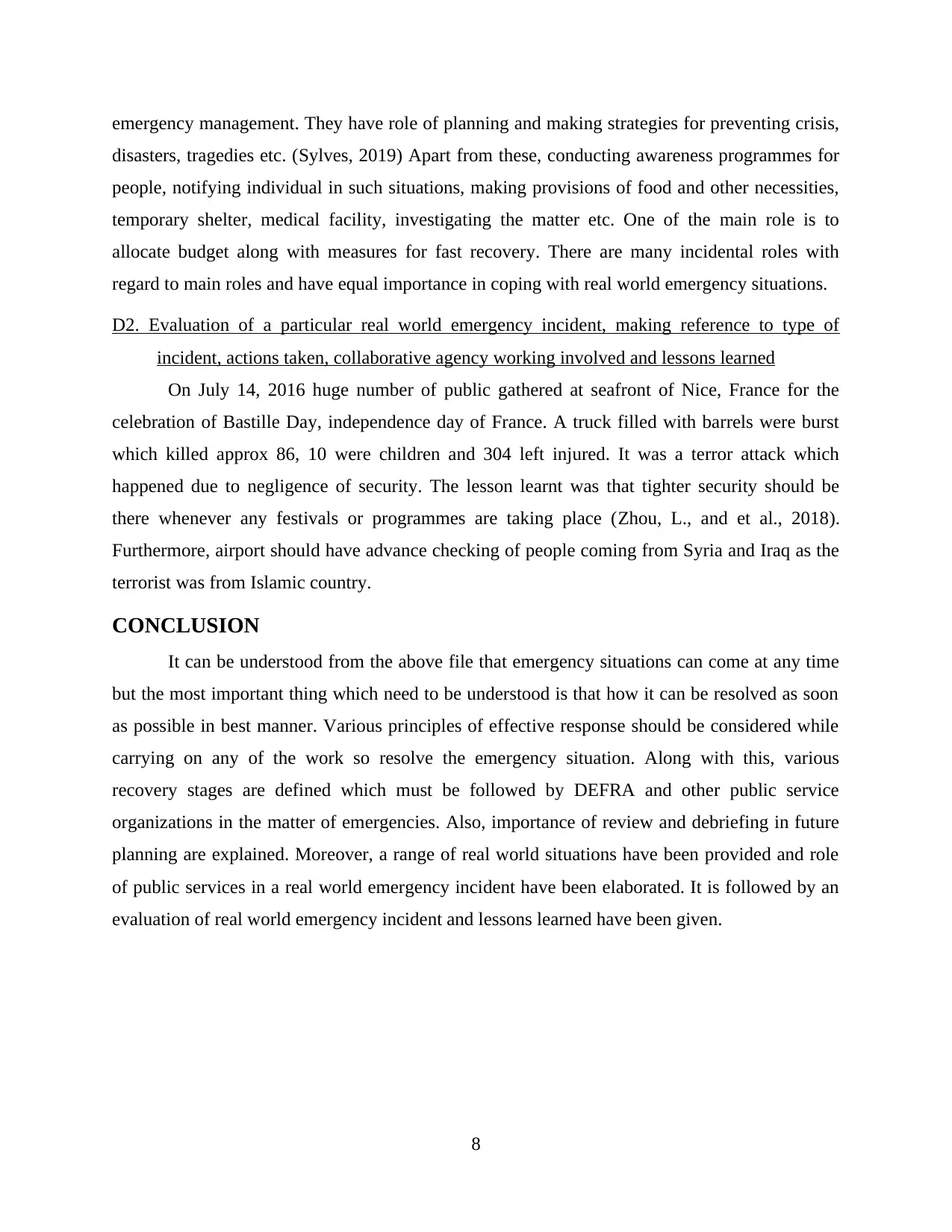
emergency management. They have role of planning and making strategies for preventing crisis,
disasters, tragedies etc. (Sylves, 2019) Apart from these, conducting awareness programmes for
people, notifying individual in such situations, making provisions of food and other necessities,
temporary shelter, medical facility, investigating the matter etc. One of the main role is to
allocate budget along with measures for fast recovery. There are many incidental roles with
regard to main roles and have equal importance in coping with real world emergency situations.
D2. Evaluation of a particular real world emergency incident, making reference to type of
incident, actions taken, collaborative agency working involved and lessons learned
On July 14, 2016 huge number of public gathered at seafront of Nice, France for the
celebration of Bastille Day, independence day of France. A truck filled with barrels were burst
which killed approx 86, 10 were children and 304 left injured. It was a terror attack which
happened due to negligence of security. The lesson learnt was that tighter security should be
there whenever any festivals or programmes are taking place (Zhou, L., and et al., 2018).
Furthermore, airport should have advance checking of people coming from Syria and Iraq as the
terrorist was from Islamic country.
CONCLUSION
It can be understood from the above file that emergency situations can come at any time
but the most important thing which need to be understood is that how it can be resolved as soon
as possible in best manner. Various principles of effective response should be considered while
carrying on any of the work so resolve the emergency situation. Along with this, various
recovery stages are defined which must be followed by DEFRA and other public service
organizations in the matter of emergencies. Also, importance of review and debriefing in future
planning are explained. Moreover, a range of real world situations have been provided and role
of public services in a real world emergency incident have been elaborated. It is followed by an
evaluation of real world emergency incident and lessons learned have been given.
8
disasters, tragedies etc. (Sylves, 2019) Apart from these, conducting awareness programmes for
people, notifying individual in such situations, making provisions of food and other necessities,
temporary shelter, medical facility, investigating the matter etc. One of the main role is to
allocate budget along with measures for fast recovery. There are many incidental roles with
regard to main roles and have equal importance in coping with real world emergency situations.
D2. Evaluation of a particular real world emergency incident, making reference to type of
incident, actions taken, collaborative agency working involved and lessons learned
On July 14, 2016 huge number of public gathered at seafront of Nice, France for the
celebration of Bastille Day, independence day of France. A truck filled with barrels were burst
which killed approx 86, 10 were children and 304 left injured. It was a terror attack which
happened due to negligence of security. The lesson learnt was that tighter security should be
there whenever any festivals or programmes are taking place (Zhou, L., and et al., 2018).
Furthermore, airport should have advance checking of people coming from Syria and Iraq as the
terrorist was from Islamic country.
CONCLUSION
It can be understood from the above file that emergency situations can come at any time
but the most important thing which need to be understood is that how it can be resolved as soon
as possible in best manner. Various principles of effective response should be considered while
carrying on any of the work so resolve the emergency situation. Along with this, various
recovery stages are defined which must be followed by DEFRA and other public service
organizations in the matter of emergencies. Also, importance of review and debriefing in future
planning are explained. Moreover, a range of real world situations have been provided and role
of public services in a real world emergency incident have been elaborated. It is followed by an
evaluation of real world emergency incident and lessons learned have been given.
8
Paraphrase This Document
Need a fresh take? Get an instant paraphrase of this document with our AI Paraphraser
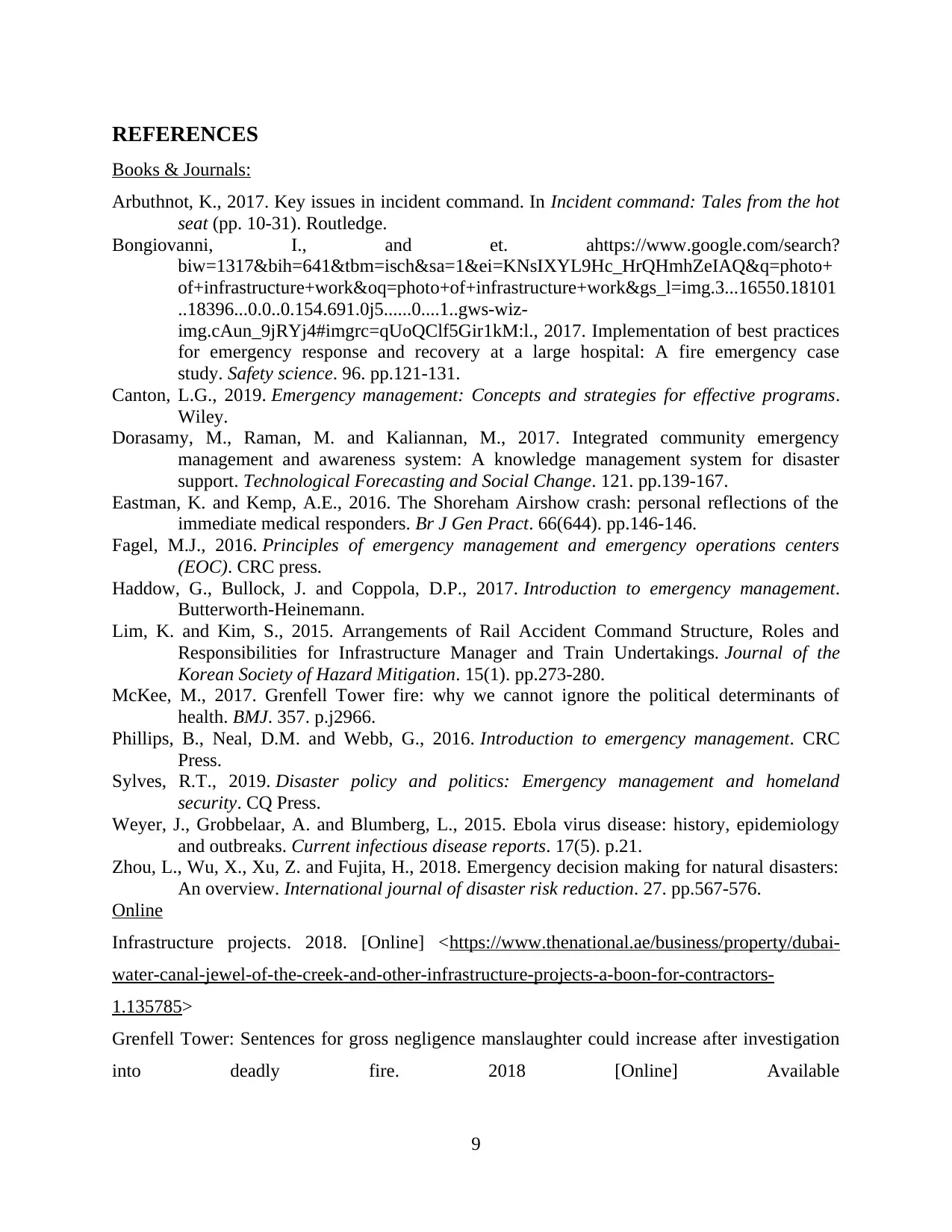
REFERENCES
Books & Journals:
Arbuthnot, K., 2017. Key issues in incident command. In Incident command: Tales from the hot
seat (pp. 10-31). Routledge.
Bongiovanni, I., and et. ahttps://www.google.com/search?
biw=1317&bih=641&tbm=isch&sa=1&ei=KNsIXYL9Hc_HrQHmhZeIAQ&q=photo+
of+infrastructure+work&oq=photo+of+infrastructure+work&gs_l=img.3...16550.18101
..18396...0.0..0.154.691.0j5......0....1..gws-wiz-
img.cAun_9jRYj4#imgrc=qUoQClf5Gir1kM:l., 2017. Implementation of best practices
for emergency response and recovery at a large hospital: A fire emergency case
study. Safety science. 96. pp.121-131.
Canton, L.G., 2019. Emergency management: Concepts and strategies for effective programs.
Wiley.
Dorasamy, M., Raman, M. and Kaliannan, M., 2017. Integrated community emergency
management and awareness system: A knowledge management system for disaster
support. Technological Forecasting and Social Change. 121. pp.139-167.
Eastman, K. and Kemp, A.E., 2016. The Shoreham Airshow crash: personal reflections of the
immediate medical responders. Br J Gen Pract. 66(644). pp.146-146.
Fagel, M.J., 2016. Principles of emergency management and emergency operations centers
(EOC). CRC press.
Haddow, G., Bullock, J. and Coppola, D.P., 2017. Introduction to emergency management.
Butterworth-Heinemann.
Lim, K. and Kim, S., 2015. Arrangements of Rail Accident Command Structure, Roles and
Responsibilities for Infrastructure Manager and Train Undertakings. Journal of the
Korean Society of Hazard Mitigation. 15(1). pp.273-280.
McKee, M., 2017. Grenfell Tower fire: why we cannot ignore the political determinants of
health. BMJ. 357. p.j2966.
Phillips, B., Neal, D.M. and Webb, G., 2016. Introduction to emergency management. CRC
Press.
Sylves, R.T., 2019. Disaster policy and politics: Emergency management and homeland
security. CQ Press.
Weyer, J., Grobbelaar, A. and Blumberg, L., 2015. Ebola virus disease: history, epidemiology
and outbreaks. Current infectious disease reports. 17(5). p.21.
Zhou, L., Wu, X., Xu, Z. and Fujita, H., 2018. Emergency decision making for natural disasters:
An overview. International journal of disaster risk reduction. 27. pp.567-576.
Online
Infrastructure projects. 2018. [Online] <https://www.thenational.ae/business/property/dubai-
water-canal-jewel-of-the-creek-and-other-infrastructure-projects-a-boon-for-contractors-
1.135785>
Grenfell Tower: Sentences for gross negligence manslaughter could increase after investigation
into deadly fire. 2018 [Online] Available
9
Books & Journals:
Arbuthnot, K., 2017. Key issues in incident command. In Incident command: Tales from the hot
seat (pp. 10-31). Routledge.
Bongiovanni, I., and et. ahttps://www.google.com/search?
biw=1317&bih=641&tbm=isch&sa=1&ei=KNsIXYL9Hc_HrQHmhZeIAQ&q=photo+
of+infrastructure+work&oq=photo+of+infrastructure+work&gs_l=img.3...16550.18101
..18396...0.0..0.154.691.0j5......0....1..gws-wiz-
img.cAun_9jRYj4#imgrc=qUoQClf5Gir1kM:l., 2017. Implementation of best practices
for emergency response and recovery at a large hospital: A fire emergency case
study. Safety science. 96. pp.121-131.
Canton, L.G., 2019. Emergency management: Concepts and strategies for effective programs.
Wiley.
Dorasamy, M., Raman, M. and Kaliannan, M., 2017. Integrated community emergency
management and awareness system: A knowledge management system for disaster
support. Technological Forecasting and Social Change. 121. pp.139-167.
Eastman, K. and Kemp, A.E., 2016. The Shoreham Airshow crash: personal reflections of the
immediate medical responders. Br J Gen Pract. 66(644). pp.146-146.
Fagel, M.J., 2016. Principles of emergency management and emergency operations centers
(EOC). CRC press.
Haddow, G., Bullock, J. and Coppola, D.P., 2017. Introduction to emergency management.
Butterworth-Heinemann.
Lim, K. and Kim, S., 2015. Arrangements of Rail Accident Command Structure, Roles and
Responsibilities for Infrastructure Manager and Train Undertakings. Journal of the
Korean Society of Hazard Mitigation. 15(1). pp.273-280.
McKee, M., 2017. Grenfell Tower fire: why we cannot ignore the political determinants of
health. BMJ. 357. p.j2966.
Phillips, B., Neal, D.M. and Webb, G., 2016. Introduction to emergency management. CRC
Press.
Sylves, R.T., 2019. Disaster policy and politics: Emergency management and homeland
security. CQ Press.
Weyer, J., Grobbelaar, A. and Blumberg, L., 2015. Ebola virus disease: history, epidemiology
and outbreaks. Current infectious disease reports. 17(5). p.21.
Zhou, L., Wu, X., Xu, Z. and Fujita, H., 2018. Emergency decision making for natural disasters:
An overview. International journal of disaster risk reduction. 27. pp.567-576.
Online
Infrastructure projects. 2018. [Online] <https://www.thenational.ae/business/property/dubai-
water-canal-jewel-of-the-creek-and-other-infrastructure-projects-a-boon-for-contractors-
1.135785>
Grenfell Tower: Sentences for gross negligence manslaughter could increase after investigation
into deadly fire. 2018 [Online] Available
9

Through:<https://www.independent.co.uk/news/uk/crime/grenfell-tower-latest-gross-negligence-
manslaughter-jail-sentence-fire-a8470596.html>
10
manslaughter-jail-sentence-fire-a8470596.html>
10
⊘ This is a preview!⊘
Do you want full access?
Subscribe today to unlock all pages.

Trusted by 1+ million students worldwide
1 out of 12
Related Documents
Your All-in-One AI-Powered Toolkit for Academic Success.
+13062052269
info@desklib.com
Available 24*7 on WhatsApp / Email
![[object Object]](/_next/static/media/star-bottom.7253800d.svg)
Unlock your academic potential
Copyright © 2020–2025 A2Z Services. All Rights Reserved. Developed and managed by ZUCOL.


